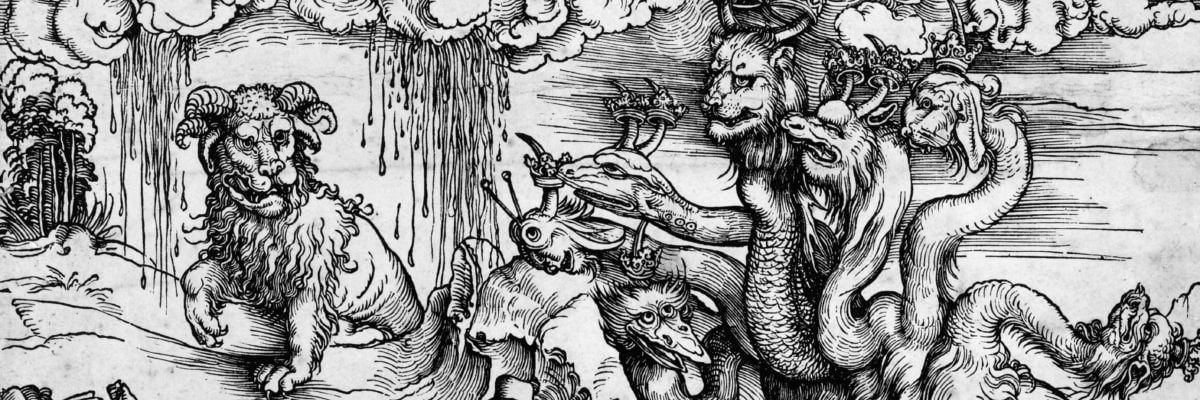
One of the most misunderstood symbols in the book of Revelation is the beast who rises from the sea in chapter 13 (there is also a beast from the land, but this article will not focus on him).
Speculations about the identity of the beast are rampant. Anti-Catholics frequently identify it with a future “restored Roman Empire,” which they also wish to connect in one way or another with the Catholic Church.
To find out who the beasts really is, one has to take a serious look at the text in question.
Often people reason like this: The beast has ten horns and rises from the sea (13:1). In Daniel 7, the prophet Daniel saw a series of four beasts rising from the sea, the last of whom had ten horns (Dan. 7:7). Therefore, John’s beast is the same as the fourth beast of Daniel. That beast symbolized the Roman Empire. Therefore, this beast symbolizes the Roman Empire.
One problem with this reasoning is that it focuses only on part of the symbolism in Revelation 13. Not only does the beast John sees have ten horns, like Daniel’s fourth beast, it also has a body like a leopard (13:2a), like Daniel’s third beast (7:6), feet like a bear’s (13:2b), like Daniel’s second beast (7:5), and a mouth like a lion, like Daniel’s first beast (7:4). The beast John sees thus incorporates symbolism from all of Daniel’s four beasts, making it impossible to simply identify it with the fourth of the series.
This is part of the “fusion imagery” which Revelation contains. Just as John saw angels around God’s throne (4:6-8) which incorporated elements of both Isaiah’s seraphim (Is. 6:2-3) and Ezekiel’s cherubim (Ezek. 10:10-14), now he sees a beast which incorporates elements of all the Daniel 7 beasts. This suggests that the new beast is like those four—the same kind of thing as they are—but not to be identified with any one of them.
Another problem is that Daniel’s fourth beast does not symbolize the Roman Empire—at least not as its primary referent. Instead, its main referent is the kingdom that resulted when Alexander the Great’s kingdom fell apart.
Among the horns of Daniel’s fourth beast arose one particular little horn who blasphemed God (7:8). This little horn symbolizes Antiochus IV (“Antiochus Epiphanes”), the Selucid king who conquered Jerusalem, blasphemed God, and desecrated the temple, and set up the first “abomination of desolation” (Dan. 11:31, 12:11, 1 Macc. 6:7) by setting up an idol of Jupiter Olympus in the holy place. (There are other times an “abomination of desolation” is set up, cf. Matt. 24:15-16, Luke 21:20-21.)
What Daniel’s four beasts have in common is that they are all pagan kingdoms that persecuted and conquered God’s people, Israel. John’s beast is the same kind of thing—a conquering pagan empire. Since it comes after Daniel’s four beasts, Rome is the logical candidate. But it’s not a future, “restored Roman Empire.” It’s the real thing, the pagan Roman Empire of the early centuries. This is confirmed by several lines of evidence.
First, the book of Revelation is explicit in stating that it concerns events that will happen “soon” (1:1, 2:16, 3:11, 22:6, 7, 12, 20). This indicates that the bulk of the events of the book (those that precede the Millennium of Rev. 20:1-10, in which we are now living) should take place shortly after the book was written, likely in the A.D. 60s.
Second, we are told that the number of the beast is 666 and that this is the number of a man’s name (13:18). Not coincidentally, the persecuting, pagan Roman Empire was headed in the A.D. 60s by Caesar Nero, whose name happened to add up to 666 in the Hebrew system of letters and numbers. (In Hebrew, “Caesar Nero” = “NRWN QSR” = N 50 + R 200 + W 6 + N 50 + Q 100 + S 60 + R 200 = 666; a variant spelling of the name, NRW QSR, adds up to 616, which some manuscripts have in place of 666).
Third, the seven heads of the beast are identified as seven mountains (17:9). Though this is not certain, these are likely the seven hills on which the city of Rome was built. (Vatican Hill, however, was not one of the seven; it is on the side of the Tiber River opposite the seven.)
Thus there is good evidence that the beast from the sea is the pagan Roman Empire of the first century and, in particular, the emperor at its head. This, again, is like Daniel’s four beasts, who were described both as four kings (Dan 7:17) and four kingdoms (cf. Dan. 7:23).
Further confirmation is found in Revelation speaking of the Jewish temple as if it were still operating (11:1), but soon to be trampled by the gentiles, along with the holy city (11:2). Shortly after Nero’s reign, the gentiles did indeed invade Jerusalem, trample it, and destroy the temple.
This suggests not only that the beast corresponded to the Roman empire in general and Caesar Nero in particular but also that the book of Revelation itself was written sometime in the early A.D. 60s, during Nero’s reign, just before the Jewish War that led to the destruction of Jerusalem and the temple in A.D. 70.



